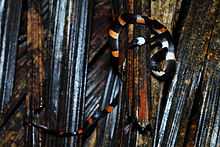Oxyrhopus petola
| Oxyrhopus petola | |
|---|---|
 | |
| At Yasuni National Park, Ecuador | |
| Scientific classification | |
| Kingdom: | Animalia |
| Phylum: | Chordata |
| Subphylum: | Vertebrata |
| Class: | Reptilia |
| Order: | Squamata |
| Suborder: | Serpentes |
| Family: | Colubridae |
| Subfamily: | Xenodontinae |
| Genus: | Oxyrhopus |
| Species: | O. petola |
| Binomial name | |
| Oxyrhopus petola (Linnaeus, 1758)[1] | |
| Synonyms | |
Oxyrhopus petola, commonly known as the false coral, is a species of colubrid snake endemic to South America.[5] According to Savage (2011) the correct scientific name should be Oxyrhopus petolarius.[4]
Common names
Other common names include calico snake[1] and forest flame snake.[3]
Geographic range
It is found in northern South America, including Trinidad and Tobago.[5]
Description
Adults may attain a total length of 91 cm (36 in), which includes a tail 22 cm (8.7 in) long.[2]
Coloration is variable. It usually consists of some combination of red and black rings or crossbands. In some individuals the light-colored crossbands are white instead of red on the anterior part of the body.[2]
The dorsal scales are smooth, with apical pits, and are arranged in 19 rows at midbody.[2]
Venom
The species is rear-fanged, and its saliva is extremely toxic to Anolis lizards.[5]
Diet
Oxyrhopus petola feeds on lizards, frogs, small rodents, birds, and probably other snakes.[5]
Subspecies
Some authorities recognize three subspecies, including the nominotypical subspecies.
- Oxyrhopus petola digitalis (Reuss, 1834)
- Oxyrhopus petola petola (Linnaeus, 1758)
- Oxyrhopus petola sebae A.M.C. Duméril, Bibron & A.H.A. Duméril, 1854[6]
References
- ↑ 1.0 1.1 ITIS (Integrated Taxonomic Information System). http://www.itis.gov.
- ↑ 2.0 2.1 2.2 2.3 Boulenger, G.A. 1896. Catalogue of the Snakes in the British Museum (Natural History). Volume III., Containing the Colubridæ (Opisthoglyphæ and Proteroglyphæ),... Trustees of the British Museum (Natural History). (Taylor and Francis, Printers.) London. xiv + 727 pp. + Plates I.- XXV. (Oxyrhopus petolarius, pp. 101-103.)
- ↑ 3.0 3.1 The Reptile Database. http://www.reptile-database.org.
- ↑ 4.0 4.1 Savage, J.M. (2011). "The correct species-group name for an Oxyrhopus (Squamata: Dipsadidae) variously called Coluber petalarius, C. pethola, C. petola, or C. petolarius by early authors". Proceedings of the Biological Society of Washington 124: 223–225. doi:10.2988/11-06.1.
- ↑ 5.0 5.1 5.2 5.3 Boos, Hans E.A. (2001). The Snakes of Trinidad and Tobago. Texas A&M University Press. College Station, Texas. xvi + 328 pp. ISBN 1-58544-116-3.
- ↑ Freiberg, M. 1982. Snakes of South America. T.F.H. Publications. Hong Kong. 189 pp. ISBN 0-87666-912-7. (Oxyrhopus petola, p. 105.)
Further reading
- Duméril, A.M.C., G. Bibron, and A.H.A. Duméril. 1854. Erpétologie générale ou histoire naturelle complète des reptiles. Tome septième. Deuxième partie. Roret. Paris. xii + pp. 781-1536. (Oxyrhopus petolarius, pp. 1033-1036.)
- Linnaeus, C. 1758. Systema naturæ per regna tria naturæ, secundum classes, ordines, genera, species, cum characteribus, diferentiis, synonymis, locis. Tomus I. Editio Decima, Reformata. L. Salvius. Stockholm. 824 pp. (Coluber petola, p. 225.)
- Reuss, A. 1834. Zoologische Miscellen. Reptilien, Ophidier. Mus. Senckenbergiana, Frankfurt 1: 129-162. (Coluber digitalis, p. 148 + Plate IX., Figure 1.)
- MacCulloch, R.D., A. Lathrop, P.J.R. Kok, R. Ernst and M. Kalamandeen. 2009. The genus Oxyrhopus (Serpentes: Dipsadidae: Xenodontinae) in Guyana: morphology, distributions and comments on taxonomy. Papéis Avulsos de Zoologia 49 (36): 487–495.
External links
| ||||||